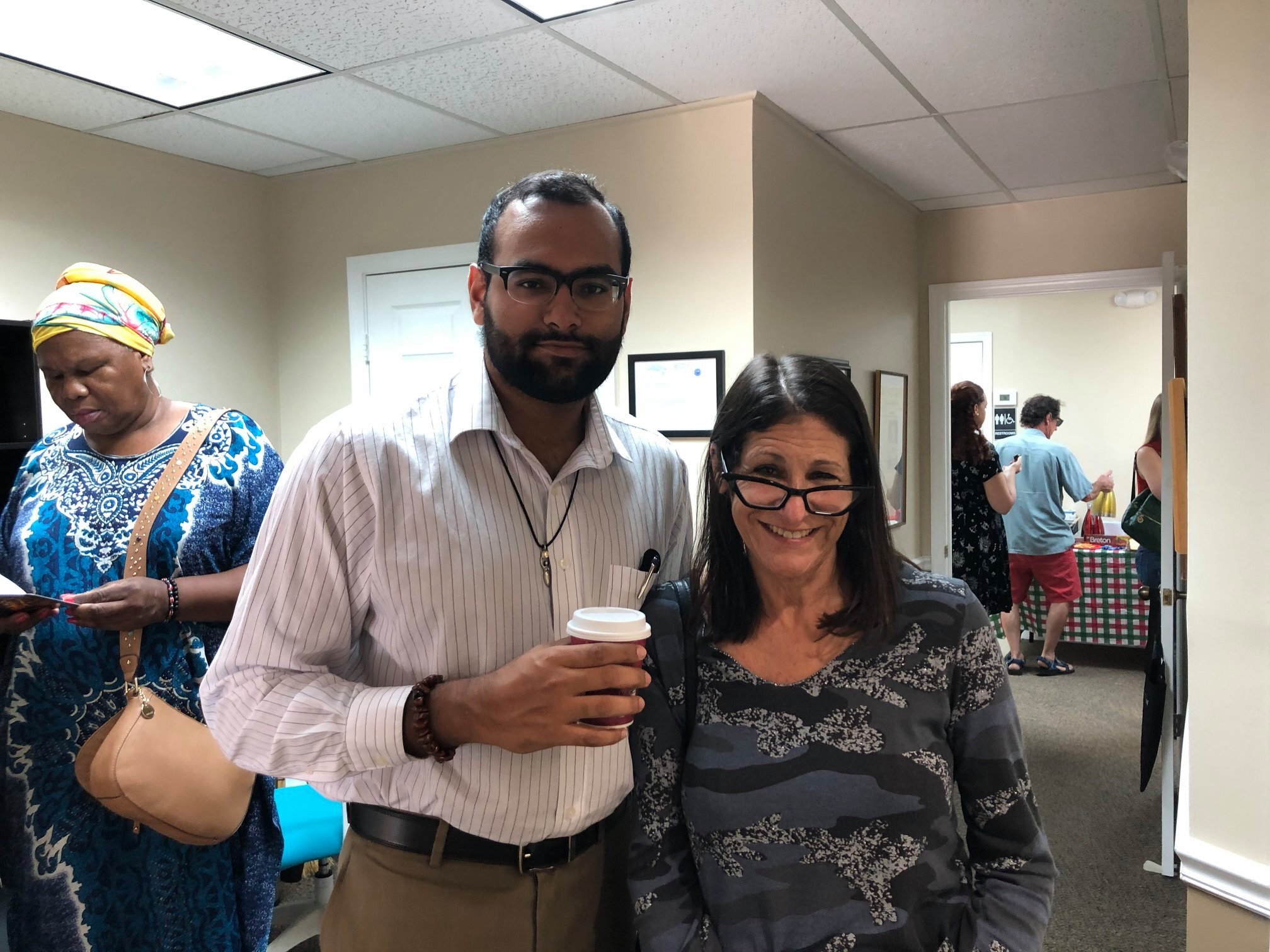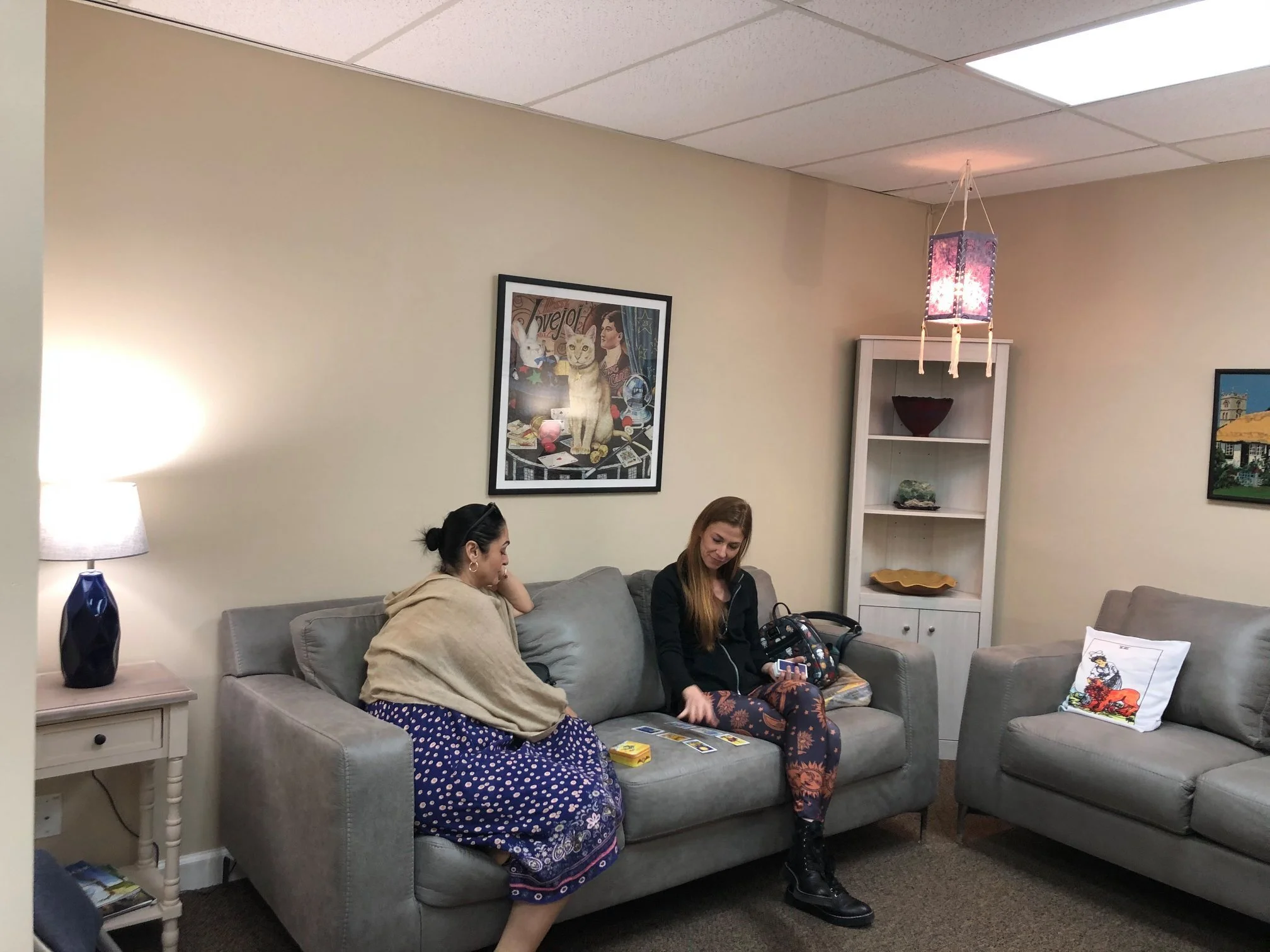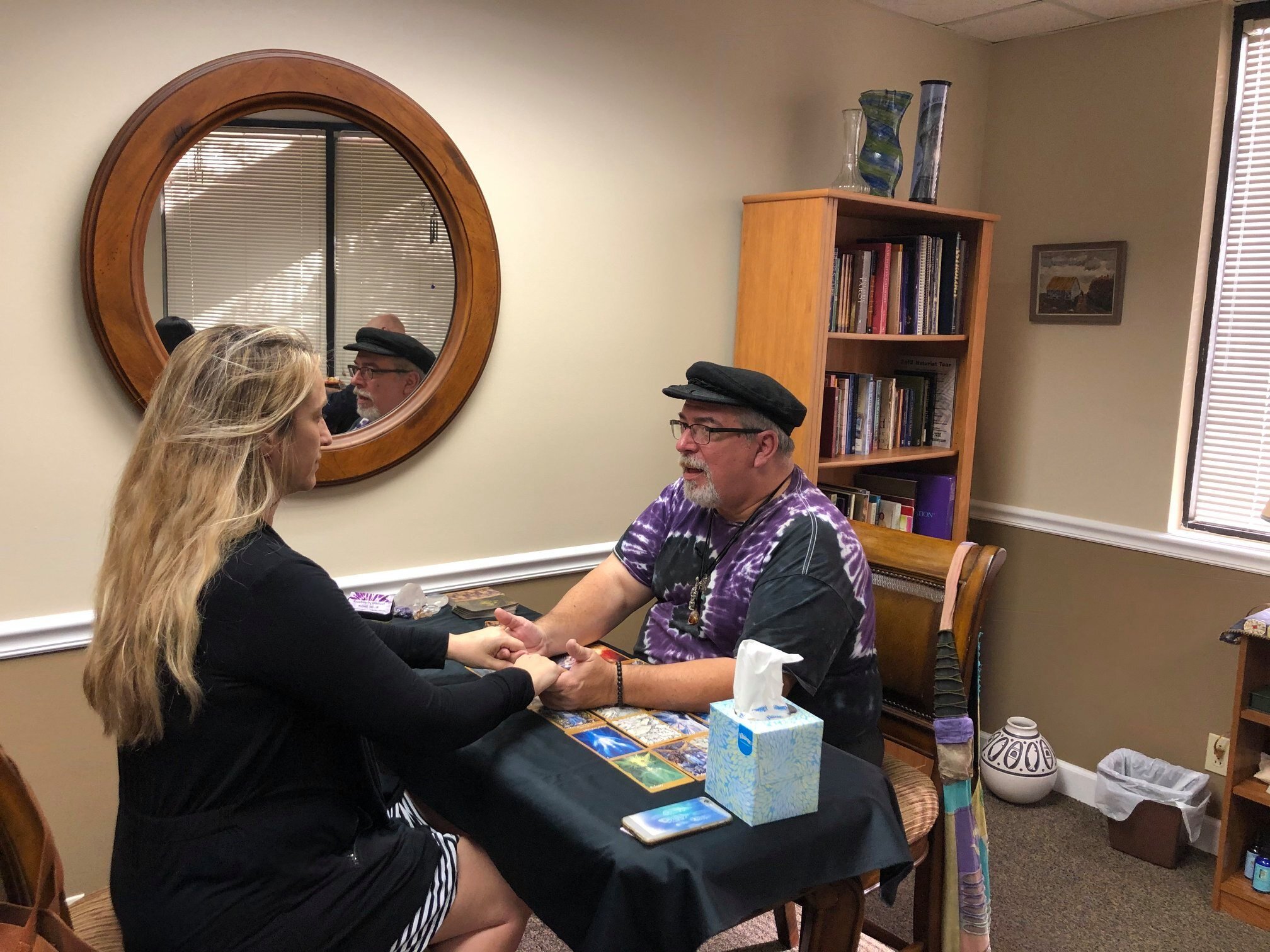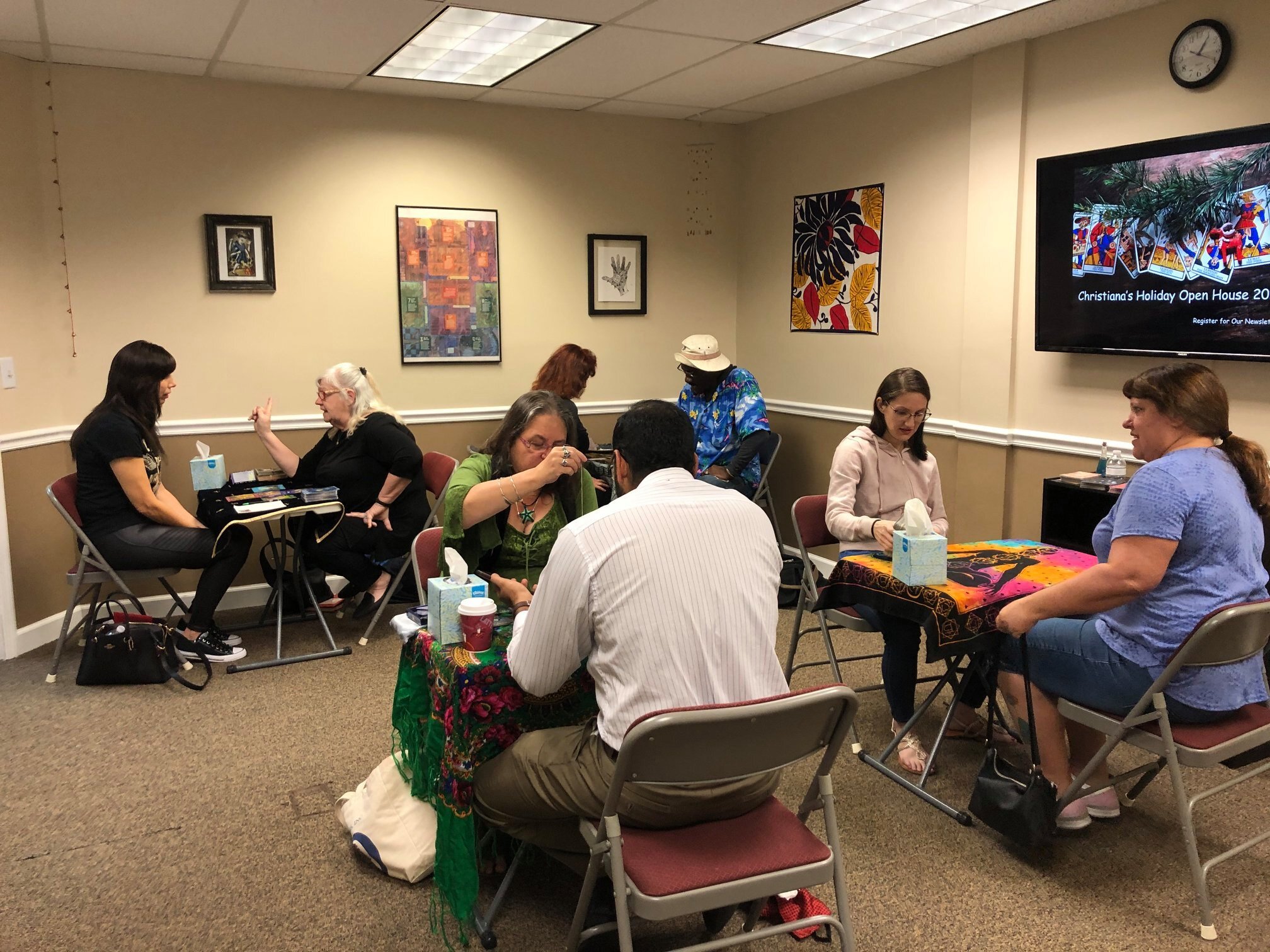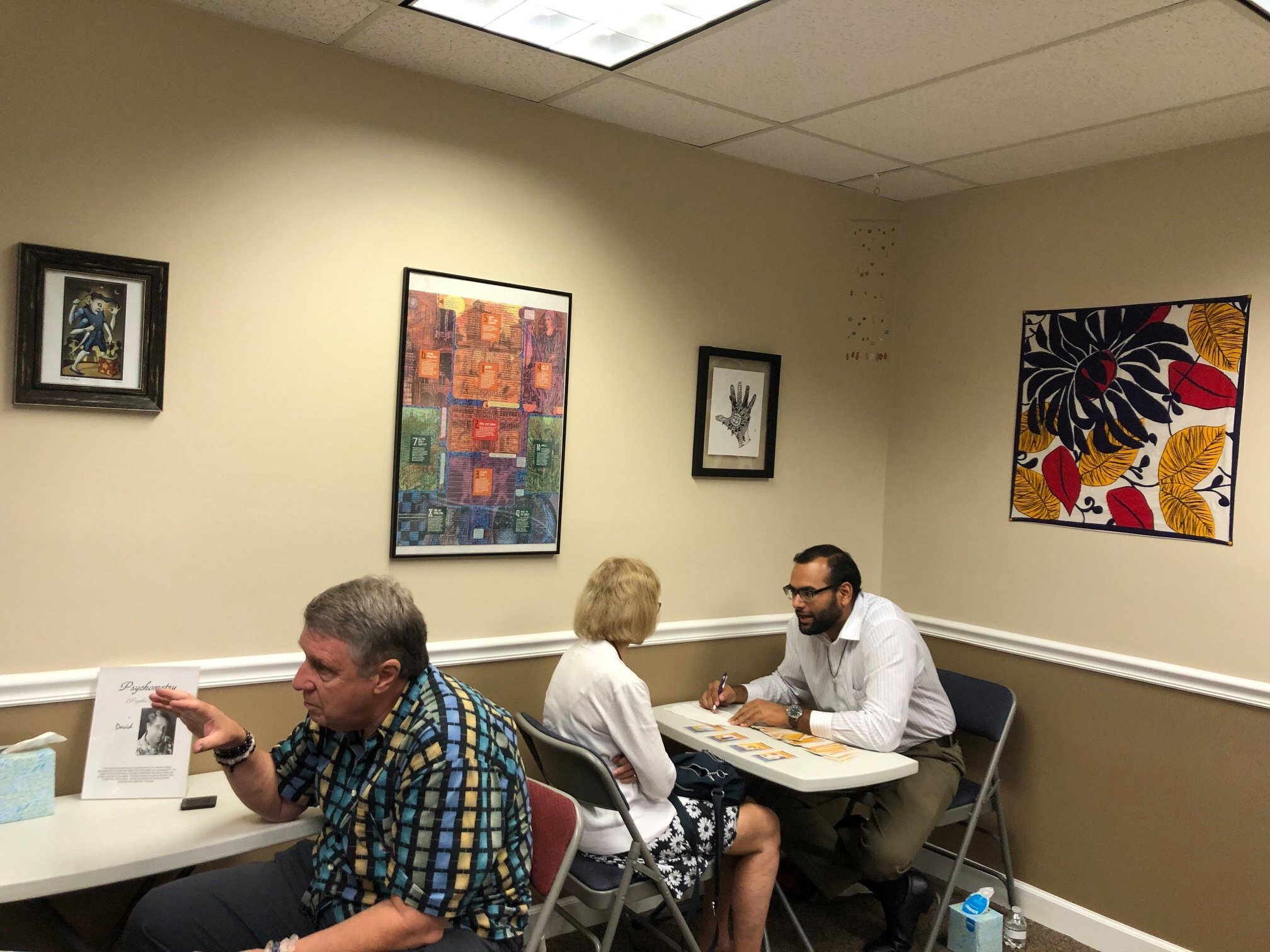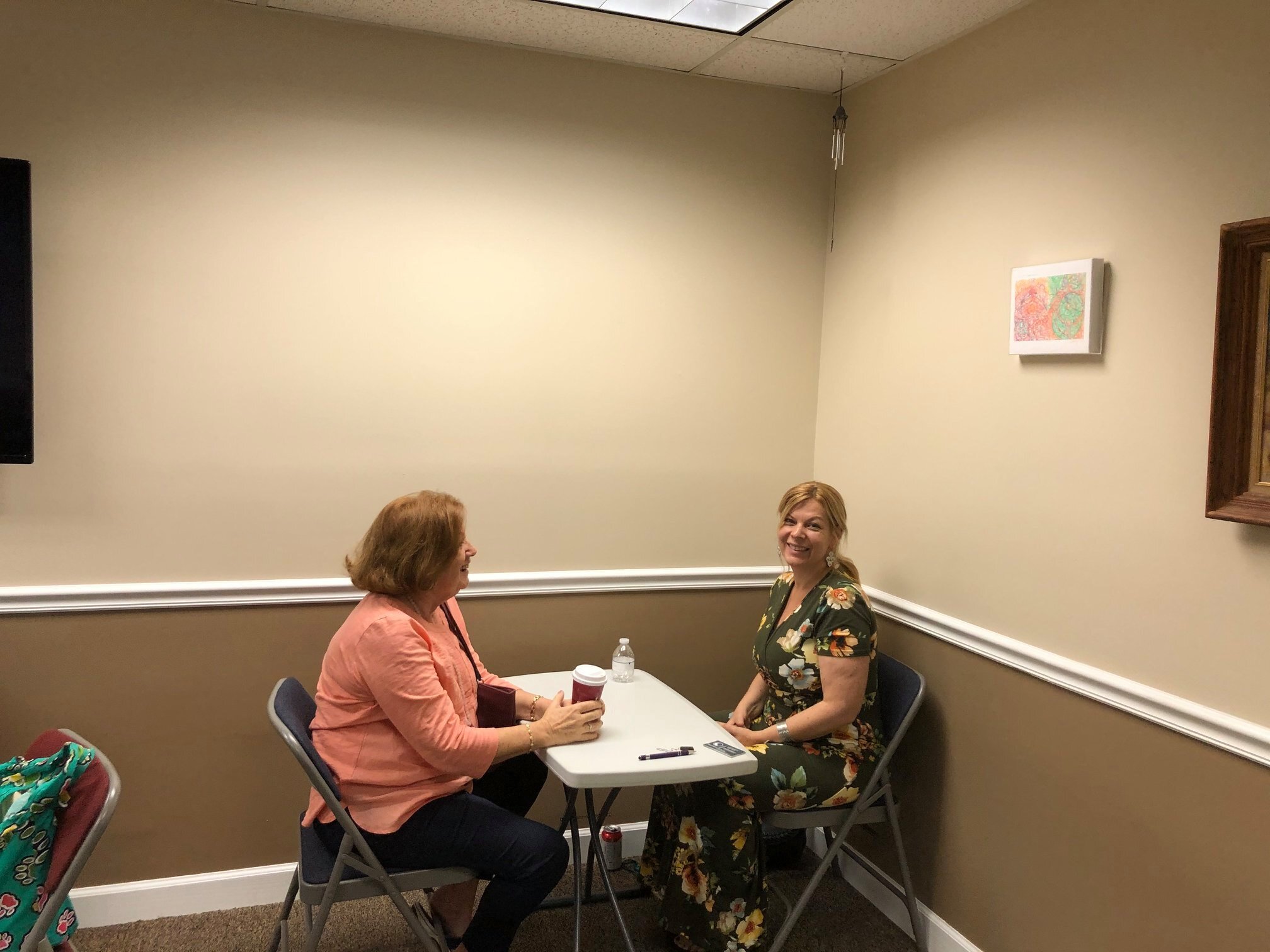
Welcome to my Community Blog for tarot enthusiasts.
Anyone with an interest in tarot, be they student, artist, collector, writer, teacher or reader, is welcome to
to include here.
When the Card Doesn't Seem to Answer the Question
Sometimes it takes some extra work to figure out what the cards are saying.
Here is a universal struggle for tarot students.
We all know the joy of asking a question, pulling a card in answer, and having that card fit the question poignantly and precisely. But what happens when the card or cards pulled don’t seem to make sense in light of the question? This problem can also occur in a spread, when a particular card does not seem to fit with the position in which it falls.
The first thing to remember is that every card appears for a reason. In professional tarot, sometimes we need to find the answers right away. With experience, this becomes easier. Nicely, in a student’s divinatory practice, or in one’s own readings, it is okay to take time to find your answer. It is sometimes necessary to research, write, meditate, ask others, and puzzle it out over time.
Whatever the nature of your practice and experience, there are numerous methods to help you find the harder answers of tarot. One thing to consider is that, often, the more difficult the answer is to figure out, the more opportunity there is to learn and grow, both in your understanding of the card(s) in question, and in the situation about which you are divining.
One great technique that I learned from Mary K. Greer is to simply say the name of the card aloud. Very often that seems to jostle a memory or an intuition and allow the reading to unfold. Following that, a good tactic is to list off everything you know about the card. If you are new to tarot, read a number of references. By listing all the possibilities, you will often find one that fits. Very often this results in a ‘d’oh moment’ as everything becomes clear.
Sometimes traditional keywords in nontraditional uses will answer the question. Fr example, if the question is about what sort of exercise would be helpful and the Wheel of Fortune appears, it might be time to take a Spin class, because a keyword for the Wheel of Fortune is ‘cycle’.
Another technique is to look at the card image and see if there is anything in the picture as a whole, or within the picture, that strikes you as an answer to the question. This can work even if the answer you arrive at has no bearing on the card’s traditional interpretations.
Many times, newer readers expect all financial questions to be answered with Pentacles, all romantic questions to be answers with Cups, and so forth. Of course, this doesn’t happen in actual practice. It’s important to understand that any card can be interpreted in any context.
The trick is always to allow the time, energy, research, and intuition to find the answer.
Two-Card Tarot Spells
A tarot exercise in combining cards to create change!
Two-Card Tarot Spells
I love to think about, write about, teach, and practice tarot magick. Over the past many years, I have become more and more convinced that we can use the cards for manifestation as easily as we can for divination. Very often, we can do both at the same time.
I write about tarot magick on my 78 Magickal Tools blog.
Sometimes the exercise of thinking about which cards to use for a particular need also helps us understand specific cards and card combinations in new ways.
The magickal tarot exercise I want to share with you here is simple, yet profound.
Think of a particular need that you have, or that someone you know has. What two cards would serve that need, when combined together?
Here are three examples.
To break a repetitive pattern in life, the Wheel of Fortune and the Ace of Swords.
To be accepted to a school or education program, The Hierophant and the Page of Swords.
To have a fair outcome in a court of law, Justice and Judgement.
You can use a pair of cards to manifest something, create change, or influence an outcome in a number of ways. You can meditate with the cards. You can do a ceremony with the cards in a central place on your altar. You can make a jar candle with images of the cards on the jar. In all cases, you must visualize your desired outcome in the present tense as a certainty, rather than as a wish.
If you happen to see a pair of cards that you have already used for a magickal purpose appear in a reading, consider that the cards may be speaking of the same or similar situation.
What two-card tarot spells can you think of?
Share them in the comments if you like!
Are They Cheating? Handling the Tarot Reader's Dilemma
If you read tarot, you will want to handle this question carefully.
The topic of how to handle questions about infidelity has come up a few times in conversations with tarot students and friends recently. “Is my partner cheating on me?” is, unfortunately, a classic question at the tarot table.
Before I address how I handle that question, let me discuss some things a professional tarot reader should consider regarding the uncomfortable subject of infidelity.
First, I believe a good tarot reader needs to approach every reading absent of bias and judgement. As humans, we tend to have a great deal of bias and judgement when it comes to this particular topic. To be a truly fair, impartial, ethical and helpful reader, I find it helpful to embrace the following three practices.
First, release gender bias. Everyone is capable of infidelity, not only heterosexual men. Heterosexual women cheat, lesbians cheat, gay men cheat. Yes, in some cultures there is a prevalent norm that gives heterosexual men a pass and an expectation for cheating. That, however, doesn’t mean that every man cheats, or that women don’t cheat, or that cheating doesn’t happen in same sex relationships.
Second, release judgment. The person at my table who needs my guidance may be the person who has been cheated on. The person at my table may also be the cheater, or the person with whom someone has cheated. Everyone at my table deserves compassion, understanding, and grace without judgment.
Third, not all cheating situations are the same. There is a lot of common wisdom that says things like, “Once a cheater, always a cheater,” and “If he cheated with you, he will cheat on you”. While these things may be true some of the time, they won’t be true all the time. This is another sort of judgment I try to avoid at the tarot table. Rather, I do the reading for the individuals and their relationships and interpret it free of those biases.
How should we handle it when the question on the table is, “Is my partner cheating on me?”
It’s easy to see what a quandary this might be. The potential to do damage is immense.
Right away, we need to know what our client feels cheating is. We don’t all define cheating the same way. For some, wandering into an adult nightclub would be considered cheating. For others, a flirtation or conversation might cross the line. Some spouses equate porn use with cheating. For others, the line isn’t crossed unless there is full-on sexual contact with another human.
Then, we need to remember that there can be all kinds of dishonesty and disrespect in a relationship. The cards might reflect other kinds of insult in a way that would be difficult to distinguish from sexual infidelity. We may see there is disrespect, but can we be sure that disrespect includes infidelity?
We also need to remember that some people are just plain paranoid and suspicious.
When asked this difficult question, I will pull some cards to try to get a read on the relationship and the nature of the partner. Is it in the partner’s nature to cheat? How does the partner regard my client? What is the energy around the relationship? What is the client’s tendency toward dark imaginings and unwarranted mistrust?
I usually ask the client if they have particular reason to suspect infidelity. I see how their answer to this question reflects my read on the relationship.
Never do I want to say for sure that the deed has been done. It’s not my job to bust someone, and it is not my job to break up marriages.
However, if the offense shows up strongly in the cards, and the client can relay to me stories that are corroborated by the cards, I might say something like, “It does seem like a possibility” or “This is definitely something you need to speak with your spouse about” or “It may be time for marriage counseling”.
If I don’t see signs of the alleged behavior in the cards, I will say something like, “There is no evidence here to suggest that this is happening”.
It’s important to remember that to flat-out deny something is happening when it is could be just as devastating as suggesting something is happening when it isn’t.
Very often when a person is concerned about infidelity there are other obvious signs of relationship problems in the cards. Often the cards will reveal specific kinds of abuse and disrespect which the client will confirm. Often the client wants to hear that their spouse is cheating to justify ending the relationship. In a situation like that, it is easy to point to the laundry list of known offenses and suggest the client act on those.
The truth is, cheating doesn’t usually happen in an otherwise happy relationship. We, as tarot readers, can be helpful by focusing on the obvious dysfunction in the relationship.
If the dysfunction is that the client is suspicious and accusatory for no reason, we may be able to identify the source of that problem and offer opportunities for healing. If the dysfunction is lack of communication, lack of sexual connection, lack of time together, we can identify the problem and suggest remedies.
Another thing that can happen is that infidelity will make itself known in a reading, even if the question hasn’t been asked and the client isn’t suspicious. Sometimes the cards just scream it in a way that can’t and shouldn’t be ignored.
When that happens, I don’t usually come out and make the accusation. Instead, I might suggest that there are issues of trust or communication, or that there may be another person meddling in the relationship. If the cards are particularly pointed, I might ask if infidelity has ever been an issue, or a concern. Of course, I suggest communication and counseling.
Very often, tarot readers are the first line of defense for people suffering with relationship issues. It’s important that we each have a protocol for handling difficult situations which allows us to help our clients, while doing no further harm.
While we often offer that first line of defense, we should always suggest marriage counseling, and individual counseling, when we see issues of distress within a relationship. Understanding the limitations of our practice is just as important as understanding the significant benefits a tarot reading can provide.
Five Tips to Help You Learn or Teach Tarot
Tarot is complex and learning tarot is life changing. Here are some ways to make it easier.
Whether you are learning tarot on your own, helping someone one-on-one, or teaching a class, there are several things you can do to help make things click.
The problem with teaching or learning tarot is that tarot is complex. Many times, folks feel intimidated by the sheer number of cards, decks, images, keywords and possibilities. Even worse is the anxiety about saying the right thing. That’s an anxiety that we all seem to have in one way or the other. Sometimes when applied to something profound like tarot that anxiety is increased.
The trick to learning or teaching tarot is to remove the anxiety and invite playful imagination. Students must make a connection between themselves and the cards. That connection doesn’t have to feel spiritual, and it doesn’t have to be about liking the artwork. The important connection, the thing that makes things click and produces aha moments, is when students see themselves in the cards, and see the way the cards can apply to their own lives. Here are five ways to make that happen for yourself or for others.
Break the Deck into Bite-Sized Chunks
The Major and Minor Arcana are each too big to handle as a whole at first. Break the Majors into smaller groups, perhaps the Fool as its own story, and then the twenty-one numbered cards into three groups of seven.
Break the Minors into suits Ace through Ten. You can handle the Court in groups of four by suit and by rank.
Discuss, learn and do exercises with each group to avoid having to learn or hear about too many cards in a row in a way that becomes mind-numbing. This also teaches the structure of tarot in a very organic way.
Tell Stories and Do Exercises
Use these small groups of cards to demonstrate how we tell stories with the tarot, and how the cards are connected to each other. Create divination exercises using only these small groups. For example, from the suit of Swords One through Ten find one card at random to describe how you are processing information at present.
You can also choose a card from each group cognitively to answer questions about your life. For example, from the first group of seven Major Arcana cards, which one most expresses the lesson you are working on in your day-to-day life?
Make the Psychic Connection
Don’t let the meditative, intuitive and psychic aspect of tarot be an afterthought. Begin your studies with meditation, chakra clearing, grounding, opening the third eye, creating psychic shielding and making a conscious connection to Spirit. Everything flows more easily from this place. Your study should happen in sacred space, just as your readings will.
Make Connections Between Cards and Life
When a card is pulled at random, ask how that card represents something that is happening currently. This ability to extrapolate between the image and real life is essential to tarot reading. Start developing this skill from the very beginning.
Find Yourself in the Cards
Look through the cards to find images that you identify with. In which of these cards do you see yourself? Why? If you can see yourself in a card, you are on your way to seeing others in the cards. Seeing people and situations in the cards is the primary skill we need to develop in order to read tarot for ourselves and others.
Reading Tarot Out of Order
Try these techniques to find meaning in a group of tarot cards.
Reading Tarot Out of Order
One of the best ways to become a truly efficient and effective tarot reader is to learn and practice a number of techniques. In fact, the mark of a limited tarot reader is the word ‘always’. Try to avoid ‘always’ seeing and saying the same thing for a particular card, or ‘always’ using the same spread, or ‘always’ interpreting a particular spread using the same techniques.
This past Sunday we had our monthly Tarot Meetup, Cards and Conversation, at Panera Bread in Palm City. I was thrilled that over twenty people were in attendance! Our monthly meetups are a great place to meet old and new friends, share some readings, and learn something about tarot.
Since Sunday happened to be the day of Saturn and Pluto conjunct in Capricorn, an event that won’t happen again for more than five hundred years, I decided to design a series of exercises using the three Major Arcana cards associated with Saturn, Pluto and Capricorn, which are the World, Judgment and the Devil, respectively.
One of the questions I asked folks to consider was what those three cards might mean together in a reading. People came up with some great messages. Yet, I was struck by the fact that most, if not all, of our students and readers felt the need to designate an order to the cards and read the cards in that linear order.
Reading a group of non-positioned cards is a standard tarot technique. Designating an order to the cards (usually the order in which they were pulled) and reading them in that linear fashion is also, obviously, a standard technique. And, it’s an effective technique. Typically, that linear reading becomes a timeline, which turns a non-positioned group of cards into a de facto Past, Present, Future sort of reading, or, a Situation, Obstacle or Action, Outcome sort of reading.
However, there is no rule that says that tarot cards have to be read in a linear fashion, describing a timeline, cause-and-effect, or a situation, action and outcome. While we must be able to read this way, it’s important to know that there are other ways to treat a non-positioned group of cards. The more techniques we know, the more information we can derive from the cards.
It became very clear to me that I have been in remiss in my group leadership. I have not taught my group other methods of handling groups of cards. Guess what we will be doing in our next meeting?
In the meantime, here are some ways to handle a non-positioned group of tarot cards that aren’t linear. These techniques can work with groups of cards as small as two, or as large as five or more.
Let’s use the example of the three cards from our meetup, the Devil, Judgement and the World.
When we read these cards in a linear fashion, we see a story of empowerment that comes from acknowledging and releasing our limiting behaviors.
How else might we read these cards?
We might see the state of the actual world here, where some want to end certain behaviors or traditions (Judgment) while others want to hang on to them (Devil).
We might see a reference to the World Wide Web (World) that connects us all, where we all have a chance to be heard (Judgement), yet also can become addicted and diminished by the attention we pay and the time we waste (Devil).
You can see that when you don’t attach to the order of the cards, the number of stories we can tell expands exponentially.
Other techniques for reading groups of cards include looking at what the cards have in common, to see if there is an overarching theme. If the cards have a similar message, that message can become the overriding takeaway from the reading. If the cards express opposite messages, you may be shining a light on a conflict.
Sometimes similarities in the coloring or images of the cards will give a specific message. I saw the Magician and the Nine of Cups from a version of the Waite deck recently and was struck that both cards had a yellow background, while the Magician’s cloak and the Nine of Cup’s hat were both red. I saw these cards, then, as speaking together with a message of boldness and confidence.
Sometimes cards within a group will be completely dissimilar, sharing neither messages, coloring nor themes. A good technique for blending dissimilar cards is to consider the keywords for each card and see how those keywords can work together in a sentence.
When you release your attachment to the order in which the cards are draw or laid out, or the numeric order of the card sequence, you open yourself to many additional opportunities to receive information.
Holiday Open House 2019 a Success!
Our psychic and healing community gathered to celebrate the holidays and raise food for those in need.
Our annual Holiday Open House was held at my new office in Palm City on Sunday, December 19. You can check out videos and photos on my Facebook business page.
We raised 507 pounds of food for the Treasure Coast Food Bank. Readers and healers came to volunteer from as far away as Pennsylvania and Saint Petersburg.
Throughout the course of the day we had eighteen readers and two healers sharing their skills. Our four volunteer hosts made sure things ran smoothly.
Most years when I write about this event I write about its humble origins in Putnam, Connecticut, when I was the only reader for an afternoon of free readings.
This year, I want to focus on the energy that drives this event year after year, making it bigger and better with each year that passes.
The energy is generosity; radical, revolutionary generosity. We who are busy, we who are businesspeople, we who have hundreds of things to do and never enough time to get them done, we volunteer our time and skill, bring donations of food, travel great distances and share of ourselves, each in our own ways. It’s a community effort, and an effort that requires each person to muster that one important energy, the energy of generosity.
I believe that the more generous we are, the more we will receive. The more we bless others, the more we, ourselves will be blessed.
Thank you to the many, many people who volunteered and attended Holiday Open House 2019.
Create Your Own Tarot Spreads
Every good tarot reader masters multiple tarot techniques. When we learn to create tarot spreads, we expand our tarot reading skills.
Create Your Own Tarot Spreads
A tarot spread is a diagram of card positions that allows you to do a helpful and understandable tarot reading. Typically, each position asks a question. The card that falls into that position must be read in the context of the position.
It is possible to do a good tarot reading without a positioned spread. It is also possible to include numerous spreads and techniques in a tarot reading session. Not every question calls for an entire spread. Yet, a good tarot reader needs to know when a tarot spread would be helpful, and how to most effectively work with a spread.
Each tarot spread has a theme. The spread may be comprehensive in that it addresses many or all departments of life. Or, a spread may be created to address a specific concern.
How the cards are laid out graphically can matter to the efficacy of a tarot spread. Sometimes the cards are meant to form a shape that relates to the theme of the spread. Whatever the graphic shape, we tend to notice how cards that are near each other interact with each other. We often create spreads that are like trees, where a single card addresses a larger issues and multiple cards branch from that to answer questions about that issue.
There are many traditional spreads, many books of tarot spreads, and many spreads created by professionals and shared on social media. With so many available spreads, why would you want to create your own?
There are many possible reasons to create your own spreads. First and foremost, since working with tarot spreads is such an important skill, the act of creating spreads helps us become better at reading spreads.
The act of making spreads is in itself creative, and therefore, fun. It’s also fun to share the spreads we create with others.
No matter how many spreads exist in the world, there is always room for more. There are an infinite number of questions we can answer with tarot.
As we work to create new spreads, we sometimes stumble onto new ways of working with the cards, and new techniques that improve our tarot practice.
Tarot spreads can have as few as two cards, or as many as seventy-eight.
When you create your own spread, it will likely fall into one of three categories.
You might create a comprehensive spread. This would be a larger spread, perhaps ranging between six and fifteen cards. You would want each position to reflect an aspect of life. The goal of this spread would be to get as complete a picture as possible of what is going on in a person’s life. Traditional comprehensive spreads include the Celtic Cross and the Astrology Wheel.
Another type of spread is a themed spread, or a situational spread. A themed spread might be created for a specific holiday, or a specific time of astrological transition, such as a full moon or a mercury retrograde. The graphic shape made by the cards might reflect this theme.
A situational spread could be created to use to answer a specific type of question, such as how to handle a relationship problem, or how to make a career transition.
These sorts of spreads can be shared with others and can be performed when need arises or when the time is appropriate.
It’s also possible to create a spread for a single use. These spreads are often the most powerful. I will occasionally use this method when a client presents with a unique and multi-faceted problem.
A single-use spread is likely to include many cards. You may also add positions as you are performing the spread, based on what the cards reveal.
A single-use spread allows you to break a complex issue into its components, and consider all aspects of the situation in order to find guidance, understanding and direction.
You can create a spread with a pen and a piece of paper, or you can create a spread using any sort of word processing or graphic software.
Sometimes, in a tarot reading, you might create a two- or three-card spread in the moment to answer a specific question. For example, if you are deciding whether or not to do something, you might pull one card to show what happens if you do it, and another card to show what happens if you don’t.
The more you allow yourself to explore tarot spreads and tarot reading techniques, the better you will become as a tarot reader.
Overcoming Shyness and Other Obstacles as a Tarot Reader
An aspiring tarot pro wanted to know ways to use tarot to overcome the shyness that gets in the way of business success.
Overcoming Shyness and Other Obstacles as a Tarot Reader
I received a question from a budding professional tarot reader who is struggling with shyness. She noticed that I had spoken about my own struggles early in my career, and how I overcame them with tarot. She wanted to know how I had done that, and my advice for her. This is something I think a lot of tarotists contend with. The traits that make us mystical often also make us a bit introverted.
I think one of the best ways to create personal change with tarot is to work with Court Card Significators.
The first thing you need to do is find what I call your Native Court Card Significator Do this based on your age, gender identity and sun sign astrology. For example, I am a cisgender adult woman born under the sun sign of Scorpio. Therefore, I am the Queen of Cups, because Scorpio is a water sign.
Now, look at your Court Card Significator and decide the ways in which this card’s attributes help you to be a good tarot reader, and the ways in which they might create obstacles.
If the obstacles outweigh the positive aspects, choose another card, either a Court card or not, to be your Tarot Reader Significator.
Claim this as the card of your tarot reader persona. Meditate with it, sleep with it, print it out and carry it with you. Eventually, this card will start showing up in your self-readings to let you know you are on the right track.
You can also do some great one-card divination exercises to help you access your best skills as a tarot reader. Ask questions like, what should my focus be right now? Or, which card best describes the energy I need to embrace in my tarot practice right now.
By using these techniques, you will harness the power of tarot magick and tarot divination to help you become the best reader you can be.
Watch the video for more information. If you have a question about tarot, please email me.
A Tarot Perspective Shift That Can Change Your Life
Here's a way to perceive tarot cards that can change and deepen your experience when reading for yourself or others. This practice can also help you navigate the ups and downs of life with ease and grace.
A Tarot Perspective Shift That Can Change Your Life
Here’s a way to perceive tarot cards that can change and deepen your experience when reading for yourself or others. This practice can also help you navigate the ups and downs of life with ease and grace.
I first began studying tarot with an Eden Gray book some thirty-five years ago. Gray clearly spoke of some cards as being bad and negative, and other cards as good and positive.
As I have learned a small bit about the practice of cartomancy with Lenormand cards, I’ve learned that each Lenormand card is designated as positive, negative or neutral. Understanding those designations is important to the study and practice of Lenormand. In my opinion, this should not be so with tarot.
I know that many tarotists, both beginning and experienced, see some tarot cards as good and other tarot cards as bad.
Here’s the shift in perspective that I have started advocating.
Consider what might happen if you were to believe that no tarot card is inherently good or bad.
When you think about this, you have to first realize that the study of tarot is not just about learning how to interpret the cards in a reading. Tarot functions as a book of spiritual wisdom as well as a divinatory device. When we study tarot, we need to learn both the divinatory aspects and the spiritual lessons which exist beyond the function of divination.
Each card teaches us something about life and about ourselves. These lessons stay with us and help us though life. When we understand these lessons, our ability to interpret the cards is increased, even when those deeper lessons aren’t especially pertinent to a specific reading.
When we understand the lesson of each card, we understand that life lessons themselves are neither positive nor negative.
Yet, in most decks, some card illustrations are attractive and appealing, while others are dark or even violent. Regardless, we need to reserve judgment on whether the message is positive or negative, or wanted or unwanted, until we do the reading.
In a reading, whether we find the information we receive positive or negative should depend entirely on the context of the reading. We may get answers we don’t prefer, yet, we needn’t see the individual cards, or the readings, as good or bad.
There is a school of spiritual thought that suggests there is no good or bad anywhere in the world. There is only what you like and what you don’t like. We see examples of this in nature. What is good for the lion is very, very bad for the gazelle. Tarot cards are like that. While we will always prefer to see some cards over others, each card has its place and its value.
So often I hear tarotists say that they don’t like a certain card, or a certain suit. Some people seem to fear certain cards.
If, in your tarot studies, you develop a dislike or fear about a particular card or suit of cards, this is an opportunity to learn something about yourself, or about the cards.
It may be that your dislike or distrust is based on an incomplete understanding of the card. It may be that your reaction to the card is happening because that card, or that suit of cards, is exposing something in you that needs to be healed.
Whenever we have a negative reaction to a card, in study or in a reading, we need to take this as an opportunity to learn something more about ourselves, and about the cards.
We all have favorite cards, and images that resonate well with us. Yet, in a reading, a favorite card might appear to give a message that, in the moment, is less than favorable.
Whatever personal relationships we might have with individual cards, in a reading, we need to let the cards speak, free from our relationship with them, and free from a standard idea of a card being positive or negative.
That said, it is true that in self-reading we can have very powerful relationships with the cards we recognize as “personal cards”. Personal cards might be our birth cards, our astrology cards, or cards we have had significant experiences with in the past. Their appearance in a reading will bring extra information, but, even then, should not be seen as necessarily good or bad.
As examples of how cards can change in meaning, the Sun is usually a very joyful card. Yet, it can also indicate a person who is narcissistic. The Three of Swords communicates heartache, yet it also offers an opportunity for healing.
Of the four suits in tarot, the suit of Swords gets the worst rap. That’s because four of its members are usually very dark images. In readings, those images can very often speak of sadness, anxiety, depression and other upset. Yet, when we remember that Swords are associated with the element of Air, we understand that those painful swords are generally words, thoughts, beliefs, mistrust and dishonesty that are laying us low.
It’s also true that having our heartache revealed in a reading can be extremely helpful and healing. Generally, if you can’t see it, you can’t heal it.
As a professional reader, I take those difficult cards as an opportunity to acknowledge my client’s suffering, and to hold space for their healing, as well as their sorrow.
It’s important to remember, too, that the Suit of Swords contains more positive messages than it does indicators of struggle. The Ace of Swords indicates truth and right action. The Two of Swords is the card of peace. The Four of Swords offers healing, meditation and retreat, while the Six of Swords helps us move toward smoother waters.
When we read for ourselves or for others, we need to color the reading with neither over-optimism nor fear. We need to approach the cards with an attitude of compassionate detachment. We will have an easier time discerning the most precise information if we do not confuse our relationships with the cards with our intuition about what is going on in the reading. We have to let each card speak as it will in each reading, regardless of our feelings toward a card in general.
If we refrain from judging cards as good or bad, we can approach the cards without fear, from that enlightened place of spiritual neutral and compassionate detachment.
When we read for ourselves and others we can get out of our own way and find information that is useful. We can use the cards to shift perspective, open opportunities and bring healing for ourselves and others.
The practice of seeing all cards as neutral allows the cards to speak more easily and more freely. When we are free of the judgment of good and bad, we can engage intuition more easily. It is at that point that we are able to have a truly enlightening psychic experience with tarot.
An added benefit is this. Tarot cards reflect all of life. Not all of life is pretty. Yet, to be alive is to experience all of life, and to embrace it all. When we can embrace and appreciate each of the seventy-eight tarot cards, we are more prepared for the unavoidable misfortunes of life. When we understand the lessons of all seventy-eight tarot cards, we more easily understand the difficult lessons of life. Tarot, as a reflection of life, prepares us for everything we might encounter in life. When we encounter each tarot card without resistance or judgment we become able to encounter each live experience the same way.
A Sneak Peek of Tarot of the Divine Masculine
It's always an honor to be asked to review a forthcoming tarot deck. Here are some thoughts about Tarot of the Divine Masculine.
A Sneak Peek of Tarot of the Divine Masculine
Tarot of the Divine Masculine, by Vasich and Vasich, is a new indie deck that will begin funding on Kickstarter on October 1, 2019. Marko Vasich asked me to take a look at a few of the cards in advance of the Kickstarter rollout.
One of my favorite things about being a tarot pro is this privilege. It’s so exciting to get in on the early stages of a creative project, and to be able to communicate with the talented and thoughtful artists.
I was impressed with the lovely packaging of the cards they sent to me. From that I can tell that the artists will spare nothing in the quality and presentation of this new tarot.
The theme of the deck is specific, and, because of the theme, not every tarot reader will feel called to work with it. Yet, the fact is, there are a lot of queer tarotists, just as there are a lot of queer artists. This is why it is such a shame that there are so few decks available that specifically honor this community.
One would not have to be gay, or male, to read with this deck. Yet, it is definitely a deck that celebrates men, and not in a Village People way. These men are pictured in nature, not in nightclubs. There is a fair amount of male nudity in the deck, but it feels naturist, rather than sexual. It’s important to remember that the deck artists are from Germany and Serbia, where the human body is not so often viewed in a shameful way. There is subtle Pagan imagery peppered through the deck,
I remember, years ago, speaking with a group of Dianic witches, discussing that men needed to discover their spiritual mysteries. I think Tarot of the Divine Masculine would be a good tool to help with that journey, for men of any orientation.
Six of Swords image from Tarot of the Divine Masculine by Vasich and Vasich, used with permission.
The art in this deck is splendid, detailed, and realistic. The cardbacks are reversable. The cardstock is of quality and has a pleasant finish that I can only describe as slippery matte. The card edges are black.
In a deck of men, some card names must be changed. The High Priestess has become Intuition, and the Empress has become The Provider. My favorite of the card samples I received was the Six of Wands, a fierce Celtic warrior clad in a kilt.
This deck follows the Smith-Waite tradition to the point that the cards will make sense to anyone who reads with a Waite deck. The suit of Pentacles is called the suit of Diamonds, yet seems traditional in its expressions of earthly matters.
While most of the cards aren’t overtly sexual, the Four of Cups isn’t for the faint of heart. We see a woman engaged with two men, while a second woman appears disinterested. It’s important to note that none of the deck images seem pornographic. The art style is gentle and sensuous, rather than cheap and tawdry.
Tarot of the Divine Masculine is not for everyone. That means that the people who resonate with this deck need to get behind it. Let’s make sure that this beautiful offering becomes available to those who will find wisdom in it and use it to find wisdom within themselves.




















